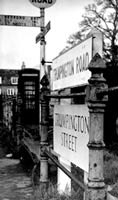Character building
Mike Exon looks at an exhibition which is a retrospective of the work of English letter cutter and typographer David Kindersley, who died in 1995.

David Kindersley called himself an “alphabetician”. He is best remembered as a stonecutter, type scientist, free thinker and for designing the gates of the British Library. As he was the pupil of Eric Gill, this may not sound so surprising, but Kindersley made plenty of lasting marks of his own.
Kindersley started training as a sculptor before turning to stonecutting to earn his living. His work with letterforms inevitably developed his insight into the science of typography, a field in which he made giant strides. He moved to Cambridge in 1945.
In his work the boundaries of science, art and craft are intriguingly blurred. Displaying all the attributes of a designer, in later life he became fanatical about scientific process – devising “optical letter spacing” and an electronic invention to establish the visual fulcrum of letter symbols. These he would seek to balance on the page according to their symmetry – so as to be in a passive position for the eye. Kindersley was the first to highlight the necessity of non-regular spacing.
Kettle’s Yard director Michael Harrison’s exhibition is an inspiring education for anyone interested in type. It succeeds in letting Kindersley’s work speak for itself. The man’s life story and craft are detailed, with fine digital media assistance in the back room from show sponsor Imagination.
We learn that Kindersley’s typography is still widely visible on many of our street name signs. We are then told of Kindersley’s opposition, on scientific grounds, to motorway signage designs, and how he subsequently devised an alternative system using an upper-case serifed type for optimum legibility. It was rejected. Good thing, too – for all its efficiency it is far too imposing on the modern eye. But in 1960 Kindersley argued: “… it should be remembered that the real way to tackle a design is to assemble – as data – all the requirements. I believe the central mistake behind much modern industrial design is to be found in the pursuit of aesthetics rather than the truth.”
The Kettle’s Yard exhibition tells an illuminating life story in its idyllic surroundings. Gill fans will see some privileged insights, too, from perhaps the best qualified commentator. Kindersley spoke of Gill as “the man who thought and then made his think”. He adds, “Thoughting and making have become two quite separate activities and young craftsmen don’t like this dichotomy.” As befalls anyone captivated by words and thoughts Kindersley became a writer – he too thinking in stone.
Gill advised him to take all the business he could get when times were hard, but you get the impression this did not prevent either from loathing such commercial necessities of their craft. As Kindersley explained in his 1990 volume Mr Eric Gill: Further Thoughts by an Apprentice: “In a very real sense Eric Gill saw the human need for making, and he saw very clearly that a society for the want of anything better had to buy the things made for the profit of shareholders rather than the things that might otherwise be made for them by craftsmen.”
If the Kindersley school contrasts a little radically to design and business conventions of today, it is nevertheless equally valid and all the more worthy of our examination.
ABCDavidKindersley: A Life of Letters, runs until 25 June at Kettle’s Yard, Cambridge, and then from 14 July to 28 August at Yorkshire Sculpture Park, Bretton Hall.
-
Post a comment



